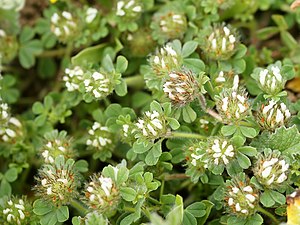Cherler's clover
| Cherler's clover | ||||||||||||
|---|---|---|---|---|---|---|---|---|---|---|---|---|

Cherler's clover ( Trifolium cherleri ) |
||||||||||||
| Systematics | ||||||||||||
|
||||||||||||
| Scientific name | ||||||||||||
| Trifolium cherleri | ||||||||||||
| L. |
Cherler's clover ( Trifolium cherleri ) is a species of the genus Klee ( Trifolium ). It is placed in the genus in the Trifolium section , Lappacea subsection . The species is named in honor of Johann Heinrich Cherler .
description
Cherler's clover is an annual , herbaceous plant that reaches heights of between 5 and 20 centimeters. The stem axis is densely hairy and only slightly branched, but often many stems are close together. It is ascending or prostrate.
The leaves are long-stalked, but the uppermost almost without a petiole. The leaves are dreifedrig, the individual pinna between 0.6 and 1.2 inches long and 0.4 to 0.8 inches wide. The blades are obovate. The leaf margin is finely indented, at least in the upper part. The tip is inverted heart-shaped. The stipules are cuticle-like, almost egg-shaped and with clearly visible greenish veins. The free part of the stipules is shorter than the fused part.
The inflorescences are sessile and many-flowered. You traverse 0.6 to 1.2 centimeters and are bracts rounded three, hairy, often colored bracts included. The shape is egg-shaped to spherical. The individual flowers are 0.8 to 1.2 inches long.
The calyx is whitish with green calyx teeth. In the lower part it is tubular to bell-shaped and 20-nerved. The calyx teeth are blunt, and more or less shaped with a triangular base. They are significantly longer than the calyx tube.
The crown is white to cream-colored, rarely reddish, and about as long as the calyx. The flag is elongated and pointed. It is a lot longer than the shuttle and the wings.
When the fruit is ripe, the calyx does not thicken and is clearly hairy on the inside. It grows together with the inflorescence axis and does not tear off even after the fruit has ripened. The calyx teeth protrude far and are also hairy feathery. The legumes are cuticle-like, egg-shaped and thickened at the tip. The seeds are more than 2 millimeters in diameter and are yellow in color. They are egg-shaped and grooved.
The number of chromosomes is 2n = 10.
distribution
The distribution area of Cherlers Klee includes all of southern Europe, Asia Minor, Egypt, Libya, Tunisia, Algeria, Morocco and the Canary Islands. Neophytic occurrences can be found in southern and western Australia.
Cherler's clover grows under trees and in grasslands, preferably on loamy or clayey soils. But it can also be found at ruderal spots and at roadsides.
ecology
Cherler's clover is self-pollinating . In Trifolium cherleri, it is not the seeds or fruits that fall to spread , but the entire inflorescence breaks down from the stem axis. This mechanism of spread is called synaptospermia .
Systematics
Cherler's clover is placed in the genus in the section Trifolium , subsection Lappacea . The closest relative seems to be Trifolium hirtum All. to be who he is very similar to. The most important distinguishing feature between the two species is the calyx, which in Cherler's clover grows together with the inflorescence axis, but remains free in Trifolium hirtum .
literature
- Michael Zohary, David Heller: The Genus Trifolium . The Israel Academy of Sciences and Humanities , Jerusalem 1984, ISBN 965-208-056-X , pp. 432-434 .
- John M. Gillett, Norman L. Taylor, M. Gillett: The World of Clovers . Iowa State University Press , Ames 2001, ISBN 0-8138-2986-0 , pp. 102 f .
Individual evidence
- ^ Trifolium cherleri at Tropicos.org. In: IPCN Chromosome Reports . Missouri Botanical Garden, St. Louis